
.Lim Hong Hin, Asean Deputy secretary general, gives his welcome remarks to participating finance ministers at the Asean 12th Finance Ministers’ Investor Seminar at Shangri-La’s Mactan Resort and Spa in Lapu-Lapu City, Cebu.
CDN PHOTO/JUNJIE MENDOZA
Deputy Secretary General Lim: Asean expected to grow 4.8% this year
The Association of Southeast Asian Nations (Asean) is embarking on a new phase in regional integration as the 10-member bloc is poised to grow faster than advance economies amid an uncertain global economic and political environment.
Asean Deputy Secretary General Lim Hong Hin said the region is expected to grow at 4.8 percent this year, above the projected growth rate of advance economies at 3.4 percent.
“However, such growth projection must be viewed against the backdrop of uncertain times, with the rise of populism and protectionism sentiment posing a challenging context to the region’s integration agenda,” Lim said during the Asean Finance Ministers’ Investor Seminar (AFMIS) in Lapu-Lapu City, Cebu on Thursday.
The AFMIS, held at Shangri-La’s Mactan Resort and Spa, served as the venue for Asean-member finance ministers to discuss investment opportunities in the region.
It was also where they discussed the progress of the Asean Economic Community (AEC) — which aims to create a single market and production base for the bloc — since it went into full swing two years ago.
The 10-member regional bloc, founded 50 years ago, currently has a population of around 650 million and a nominal Gross Domestic Product (GDP) of $2.31 trillion.
AEC Blueprint
Lim said the longer-term outlook remains robust and positive, with the new AEC Blueprint 2025 charting a forward-looking, broader, and more ambitious direction for the region over the next 10 years.
The blueprint, he said, underscores the transformative thrust of global trends, and in keeping up, the Asean will have to go beyond its existing areas of cooperation to include electronic commerce, good regulatory practice, global value chains, financial inclusion, and sustainable development, among others.
As the Asean moves away from being a production-driven economy to one that is productivity-driven, Lim said the region would increase its investment in research and development, commercialization of technology, as well as human resource development.
Support for MSMEs
Furthermore, Lim said the bloc would continue to support the development of micro, small, and medium-scale enterprises (MSMEs) as this sector would act as the backbone of the regional economy.
Fifty years since its founding, the Asean region is now becoming one of the most preferred investment destinations, being the fourth largest foreign direct investment (FDI) recipient in the world after the United States, Hongkong, and China.
Largest trader
It is also considered one of the largest traders, only trailing behind China, the US, and Germany, according to Lim.
Such accomplishments are now being recognized by businesses, including SMEs, most of which are already operating or developing strategies to operate in the Asean.
Lim, citing data from the latest European Union (EU)-Asean Business Sentiment Survey, said 87 percent of surveyed companies expected trade and investment in the Asean to increase in the next five years.
On the other hand, 74 percent of the respondents expected Asean importance in global revenues to increase over the same period as well.
Similarly, results from the 2017 US-Asean Business Outlook Survey showed that majority of the respondents considered the Asean market to have become more important for their worldwide revenue in the last two years.